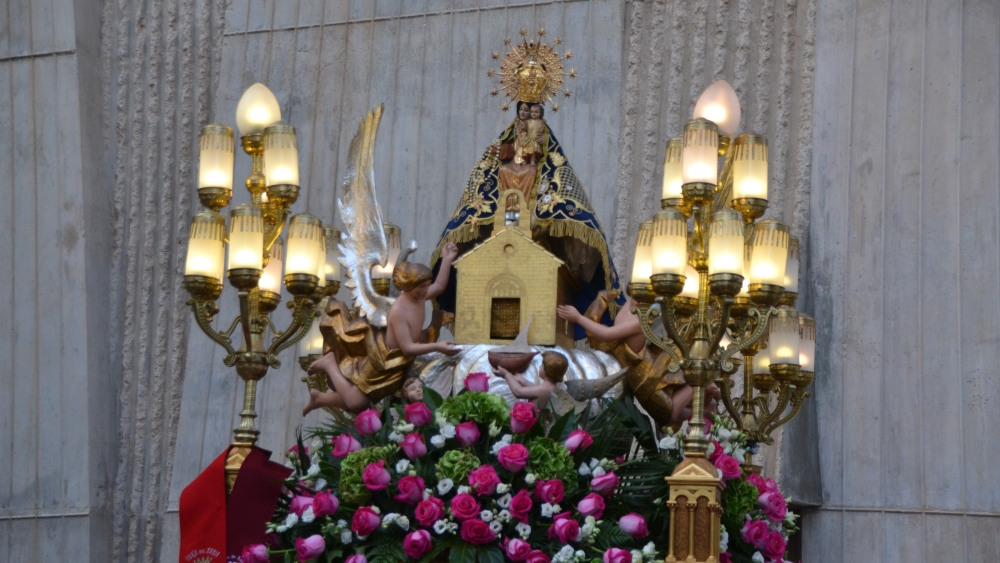
Although the official celebration is on December 10th, some Spanish towns and cities celebrate their patron ‘Mare de Deu de Loreto‘ on September 8th – the feast of the Nativity of Our Lady. In Jávea, she is the patron saint of the port area and regarded as a protector of its fortune, both on land and sea and the fiestas that honour both her and the Santísimo Cristo del Mar take place between the last full weekend of August and September 8th.
The origin of these festivities is unclear. The first printed mention of such celebrations date back to a press article in 1896 which meant that the 125th anniversary was celebrated in 2021 (although, due to the pandemic and the restrictions it imposed on the population, it couldn’t be marked in a proper sense until the following year). However, it is thought that their origin is even earlier.
According to the historian Manuel Bas Carbonell, the festivities could have originated as a reminder of the naval battle off the coast of Xàbia in 1679 when a single Christian ship, “Our Lady of Loreto”, fought off seven Turkish warships whilst other sources suggest that the celebrations have their origin in 1850 when an Italian ship carrying an image of the Virgin of Loreto ran aground in the vicinity of Cap Prim and sailors from Xàbia rescued it and took her as their patron saint, despite the fact that they had already venerated the Virgen del Carmen for some centuries.
However, to confound the matter, there was a small chapel built much earlier in the mid-16th century which was dedicated to “Mare de Déu de Loreto” in an area that was occupied mainly by the fishing community which sought safety from marauding pirates behind the high defensive walls that once surrounded the town. It was demolished in 1881 after the collapse of one of its vaults caused the death of a resident but its memory is preserved in the fountain designed by master stonemason Vicent de Gràcia in the square that now bears his name whilst an adjacent street is named Calle Virgen de Loreto.
The building of this chapel suggests that the veneration of the Virgin del Loreto was already in place long before the naval battle or the floundering of the Italian vessel. Whatever the truth, it is clear that the image has been venerated by Xabieros for several centuries.
Iglesia de Nuestra Señora de Loreto
A church dedicated to the Virgin of Loreto existed in the port for some time, a modest building alongside which was a school. In the late 1960s, the need for a larger church with greater capacity to serve both a growing population and an increase in regular tourism saw a new temple built on the same location. Its construction was funded by donations organised by then Minister of Finance, Mariano Navarro Rubio, who encouraged the summer vacationers to make a contribution whilst the State would pay the balance.
Designed by Asturian architect Fernando García Ordóñez (who had also designed the chalet built for Navarro which now sits behind the Parador de Jávea), it is a remarkable example of modern church architecture, ranking alongside Liverpool Cathedral in the UK and the Cathedral of Brasilia in Brazil, and was nominated for a National Architecture Prize in 1969 (it missed out to the Museo Español de Arte Contemporáneo in Madrid).
Officially inaugurated on June 3rd 1967, it has a very unusual design of reinforced concrete which resembles a boat crashing through the waves. The twelve pillars, considered to be the twelve apostles by some, or winged angels by others, support the unique roof; wander inside and you will see that the ceiling resembles the wooden hull of that boat, a result of a great effort from master carpenter Manuel Serra.
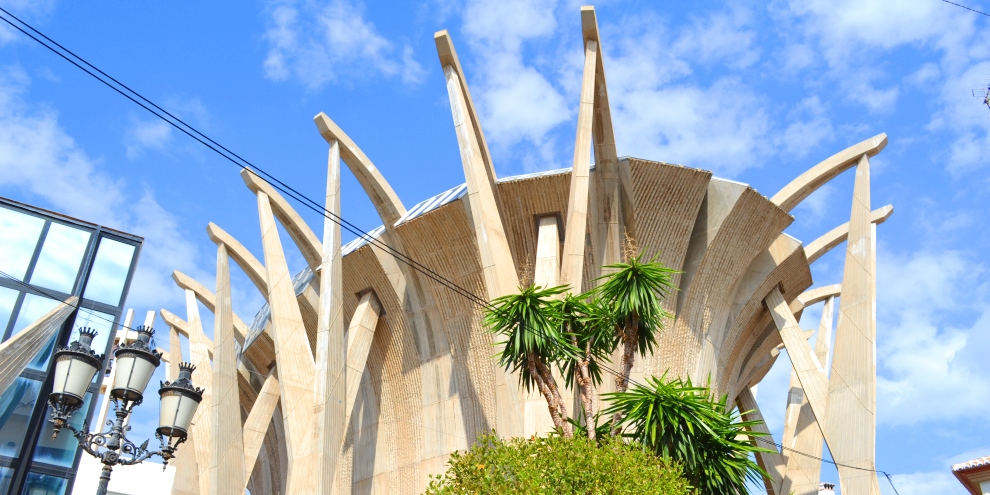
The Festivities

The festivities begin on the last full weekend of August so that exact day varies but they always end on September 8th, the feast day of Mare de Déu de Loreto, which is a local bank holiday in Xàbia.
The organisation of the celebrations is the responsibility of the Comissió de Festes Mare de Déu de Loreto which is made up of dozens of volunteers of all ages and they are assisted by the Mayorales, the main protagonists of the festivities, couples who are elected each year to serve as the main representatives of the fiesta. The men usually wear a very formal suit and tie whilst the women wear long white dresses and they are formally presented at a special ceremony on the first day of the celebrations, an event which kicks off over two weeks of fiesta.
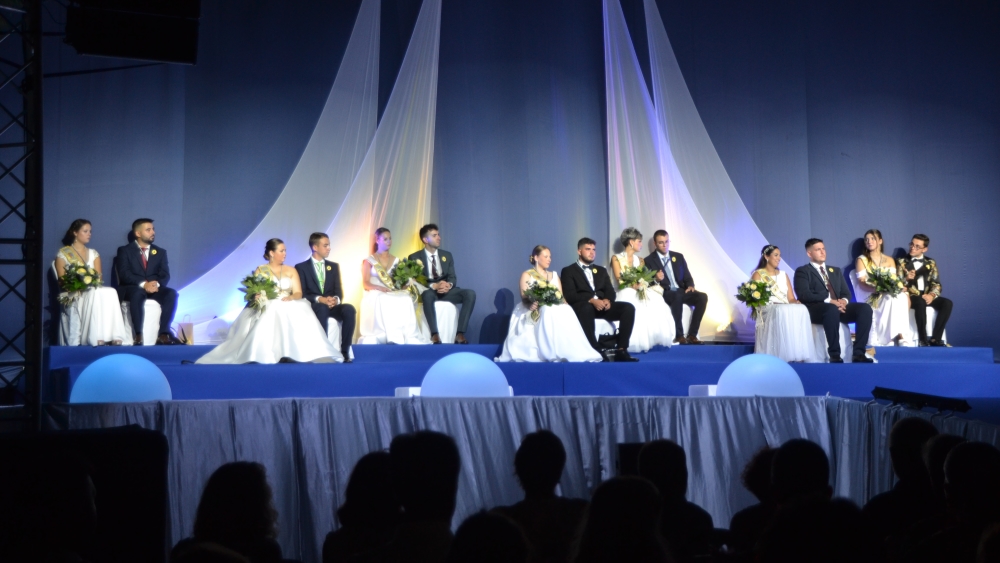
The Presentation
Like most fiestas, everything is launched by way of a special ceremony which in recent years has taken place on the wide Avenida de Lepanto where a large stage is built to present the mayorales for the year. There are normally some musical numbers, dances or acts reflecting the maritime heritage of the port zone. And there are, of course, those beloved long speeches, normally by the President of the Organising Committee, the councillor responsible for the Department of Fiestas and the Mayor. Representatives of other fiestas, both in Jávea as well as surrounding municipalities such as Gata de Gorgos and Benitatxell, often file onto the stage to honour the ‘mayorales’ with gifts.
At the conclusion of the official ceremony, the whole audience rises to its feet to stand in respect as the stirring anthem of the Comunidad Valenciana called ‘Himne de l’Esposició‘, composed in 1909 but based on a 16th-century anthem dedicated to Saint George who was the patron saint of the Kingdom of Valencia. The night concludes long after midnight with a modest firework display followed by music and dancing well into the early hours. Fiesta has started.
Bous a la Mar
Quite possibly the biggest attraction of the fiesta – and the most controversial – is the bous a la mar – loosely translated as “bulls to the sea” – which is popular along the eastern coast of Spain in the Comunidad Valenciana and Catalonia.
A special sand arena is constructed on the wide harbour pier closest to the port area and next to it, under a huge marquee, is the “world famous” (their words) Baret dels Bous. Despite the controversies and regular protests by anti-taurino activities, the event is hugely popular and attracts thousands of people to the port for each session. The atmosphere is infectious, although the music is often too loud and the crowds are often too much. But it’s the centre of life in the port for a few days
Three sides of the arena are enclosed by large temporary stands which are divided into two distinctively different sections. Below is where those who want to get right up close to the action should go, squeezing between the bars to access the sandy arena or just be up close and personal to both animals and the humans they’re chasing; children aren’t allowed to enter these sections whilst glasses and bottles are not permitted. Above this dark and narrow corridor are the seats and, unlike the Fogueres in June, there is a charge to access this area; you can pay individually or you can buy an abono to provide access for every act without having to queue up for tickets every day. The seats fill up quickly, especially with families, so it’s advisable get there early.
The fourth side of the arena is open and there is a fairly long drop into the waters of the port. It is here that most “runners” gather for it provides an additional and somewhat more spectacular escape from the oncoming horns – the sea. Anyone can enter the arena and test their courage, anyone except the under-aged and those who are clearly drunk, both of which will be politely escorted back to safety by one of the main safety volunteers provided by both the fiesta commission and ACT Xàbia, the bull-running association in the town.
Whilst most dive at the very hint of a charge, the brave will wait until the very last moment before plunging into the waters below for they want to try and encourage the animal to follow them. Occasionally one does. Waiting patiently, a small rowing boat moves quickly to intercept the animal. The animals can swim to a certain extent but the role of the volunteers in the boat is to lasso the head to lift and hold it out of the water before rowing to dry land and releasing the animal back into the holding pens at the far end.
In addition to the bull events, there are several other acts which take place in the arena. One evening not to miss is the competition between recortadores, teams of young men who twist, turn and somersault over the horns of the advancing animal. They come from all over the region to take part in the event and compete to take home the fiesta trophy as the best team.
Quite a few visitors don’t actually watch the action in the arena but take advantage of the fabulous Baret dels Bous. The bar is manned by volunteers from the fiesta commission and by the mayorales of the year. In the centre of the bar are several huge grills around which many cooks gather to prepare to perfection tasty sardines, tuna steaks, mussels, crayfish, shrimp, calamari rings and much more. Most punters quench their thirst on a hot late summer evening with a couple of the quintessential small bottles of beers – quintos – whilst there are also soft drinks and water available. It seems like a crush at times but don’t be timid. Lean forward with confidence to catch the eye of a server – and double up your drinks order!
The Religious Acts
Día del Santísimo Cristo del Mar (September 7th)
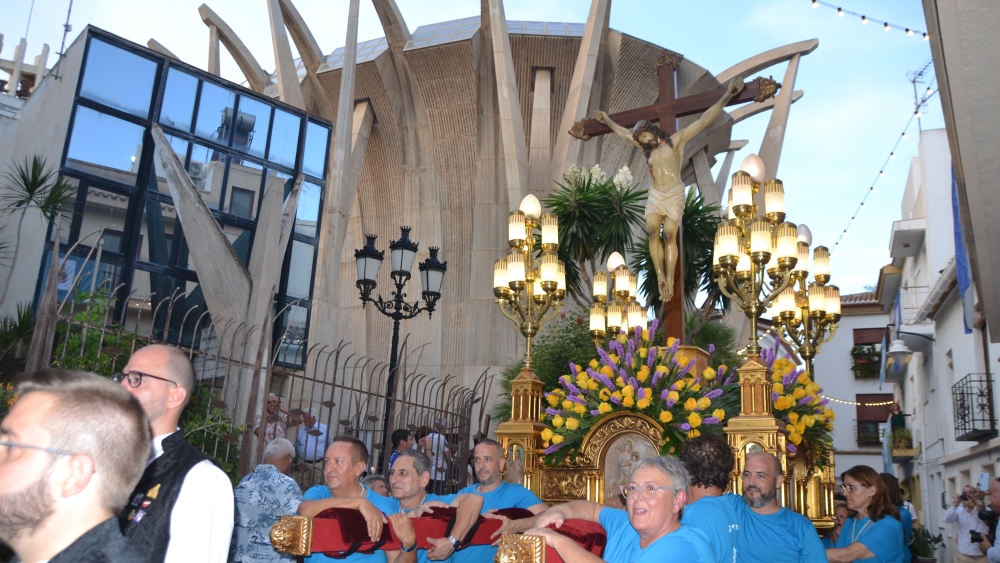
The penultimate day of the festivities honouring Mare de Déu de Loreto is dedicated to Santísimo Cristo del Mar – the Christ of the Sea – after whom one of the main streets in the port zone is named where a “street party” is held during the early afternoon.
In the early evening, the town band joins with the fiesta commission in a short parade to pick up the mayorales for the special mass at the Loreto church after which there is a parade through the streets of the port with the image of Santísimo Cristo del Mar. It’s a rather solemn affair; there’s no sweet-throwing nor is there music to dance to. Instead, everyone carries a lit candle, often struggling to keep the flame if there is a strong breeze. It’s an effective scene as night falls and the parade snakes through the port and returns back to the church.
A recent addition to the programme is what is known as the “Albà de la Mare de Déu de Loreto”, a symbolic act at midnight which welcomes the start of the final day of the festivities and the day dedicated to the patron saint. During this act, several firework bouquets are set off from different points across the Duanes de la Mar area.
Día de la Virgen de Loreto (September 8th)
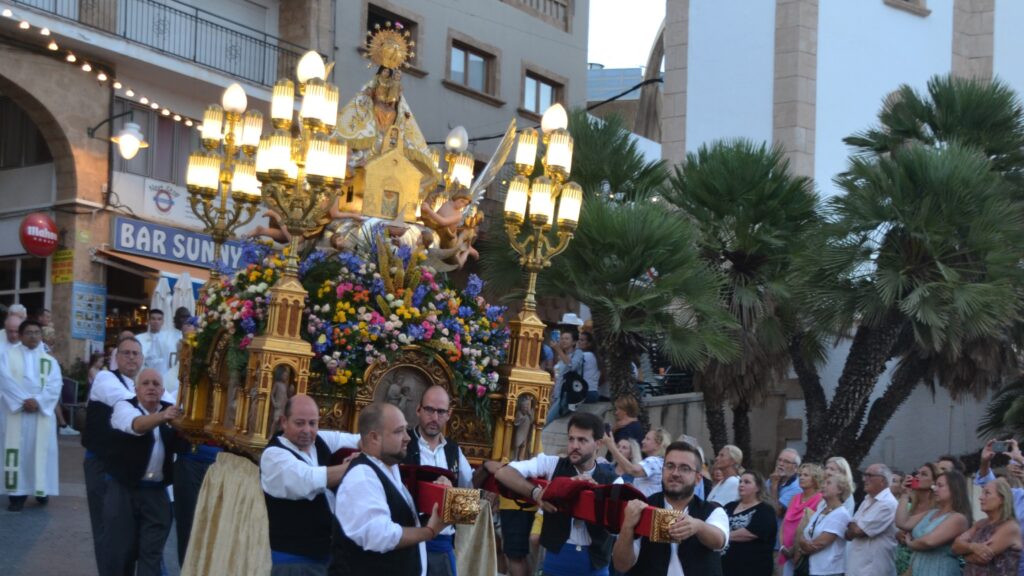
The final day of the fiesta is a local holiday in Xàbia and the day opens with the traditional despertà through the streets of Duanes de la Mar before the church bells ring out in celebration. Everyone will be dressing in their finest on this special day for there is a mass to attend at midday. Anyone can attend but space is limited so it’s best to head to the church early.
After the mass, the officials will make their way down to Avenida Jaime I where pyrotechnic engineers will have spent the morning placing rows of launchers weighted down by sandbags and strings of fire-crackers hanging a couple of metres above the ground. This is the famous mascletà, a celebration of pure noise.
A single rocket advises the imminent start of that noise and then the excitement lifts. The ‘mascletà’ has several specific parts: the start which has both sound and visual effects, the ‘body’ which grows in intensity and volume until the ‘earthquake’ which is well-named as the explosions start to rock the ground. The display climbs to a crescendo with increasing intensity until a deafening aerial bombardment brings the display to a stunning end.
That evening there is a solemn procession accompanying the image of Mare de Déu de Loreto through the streets of port. It’s a long but very important procession by candlelight, the flames struggling if there is the slightest breeze. When the procession returns to the church, the fiesta is almost over. There is just one final act to finish everything off.
Close to midnight, massive crowds will gather along the coast from the port and all way down towards the Arenal, packing the stone beaches with chairs, tables and barbecues as well as providing the beach bars with a very welcome end-of-season boost to the coffers. Those restaurants and bars along the promenade will have been fully booked on this night for weeks so it’s always best to get in early rather than try and find a table on the night.
Everyone has flocked to the coast for the massive firework display which explodes from the surface of the water. It has a huge reputation and rarely fails to impress. Colour explodes in the night sky, forming distinct shapes, whilst other rockets bounce along the surface of the dark sea, seemingly exploding into life from under the water. It’s a stunning display by the world-renowned Valencian pyrotechnic company Ricardo Caballer who have delighted around the world and the loud applause that always follows the end of the display is credit to their popularity.
By the way, don’t bother trying to park in the port for there are few free spaces and it’s a nightmare getting out at the end of the evening unless one has a particular liking for lengthy queues. Instead, look for spaces in either Avenida d’Ausis March or Avenida de Augusta and walk down.
Other Activities
In addition to the Bous a la Mar and the religious acts, there are many of other activities that cater to all ages.
- Día de los Niños y las Niñas (Children’s Day)
Children’s Day is a much-anticipated day for all the family. The younger members of the community are a vital part of a fiesta for it is they who will continue the traditions into the future so they are never forgotten. There are traditional games, inflatables, a meringue fight, a water fiesta, paella and drinks and it’s normally finished off with the Grand Float Parade in the evening. - Día de las Peñas Marineras (Peña Day)
It is a general opinion that a fiesta cannot be so without its peñas and the port fiesta is no exception. There are more than a dozen well-established groups dedicated to taking great advantage of the festivities of Loreto and many of them offer their services to the fiesta commission to organise many of the acts during the celebrations. Their special day has become rather diluted in recent years but still includes a fun procession, a communal lunch and the Bous a la Mar. - Día de los Mayores (Senior Citizen’s Day)
September 6th is the day for the senior citizens in the community. During the morning, Penya La Bufa hosts a brisca tournament for the over-50s. Brisca is a popular Spanish card game normally played by two teams with a special 40-card pack and a series of common signals which can be used to pass information between partners, such as raising the eyes for an ace of trumps or pouting the lips for the king of trumps. Look closely next time you see a game being played. Later in the morning, the mayorales, armed with Coca María and mistela visit the senior citizen’s residental home of Asilo Hospital Hermanos Cholbi and the Santa María de Betania day centre in Placeta del Convent. - La Ofrenda de Flores (Flower Offering)
The mayorales, the mayor and members of the council, the peñas, schools, groups and associations gather to participate in the flower offering. After parading through the streets of the port, they wait patiently outside the Loreto church to make their offering to the image of Mare de Déu del Loreto, filing into the church for photos. - Noche de Ronda (Night of the Minstrels)
The music and singing is provided by La Tuna de Xàbia, a popular local band of minstrels dressed in their familiar red-and-black outfits. The mayoralesas, dressed in their stunning white dresses, wait outside the front door of their homes or apartment blocks which have been colourfully decorated with plants and flowers. The entourage arrives, makes a stirring speech, there is the thunderous echo of bangers and rockets, and then the band plays a couple of tunes. Her escort may take her in his hands to dance in front of the group; sometimes a member of the band will step and take on the responsibility. The process continues until all the mayoralesas have been visited and the whole group moves on to the headquarters of the fiesta commission in Calle Severo Ochoa where there are drinks and snacks for everyone.

